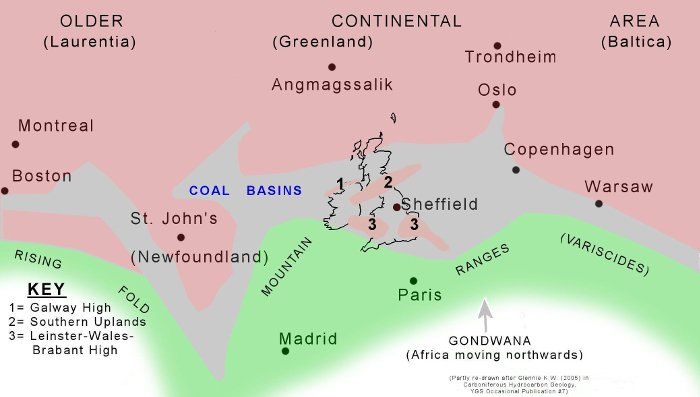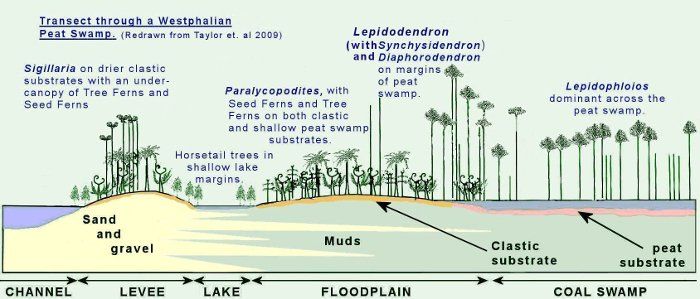Recording, conserving and promoting the landscape and rocks of the Sheffield region
The Palaeoecology of Arborescent Lycopods
The fossil record for arborescent (tree-like) lycopods is extremely good. This is because they grew over a very long period of time in extensive depositional swamp environments which reached from what is now the eastern USA to Ukraine. This meant that many of the plants became buried and fossilised. (See Fig. 1). Much later they were widely discovered during mining operations.

Fig. 1: Sketch map of the Carboniferous Coal Basins
Partly redrawn after Glennie, K.W. (2005) in
Carboniferous Hydrocarbon Geology, YGS
The Late Carboniferous coal swamps developed on a waterlogged, equatorial coastal plain, with a high rainfall that fed very large river systems. These periodically breached their banks and flooded parts of the adjacent vegetated floodplain, sometimes killing and burying the upright stems in sand. These ever changing wetland habitats became dominated by lycopods which evolved into new species according to the demands of the different habitats they were able to colonise. (See Fig. 2). Although superficially tree-like, lycopods were very different in their ecology, construction and the way they functioned, to what we call trees today.
The Main Lycopod genera of the Coal Swamps
The coal swamp terrain had a variety of habitats and water depths, some with peat substrate and some with clastic sediment substrates, like mud and silt. The geological evidence indicates that five species of arborescent lycopod dominated the coal swamp environments, with relatively fewer other plants growing alongside.

Fig. 2: Sketch Section across a Coal Measures peat swamp. Redrawn from Taylor et al.
Lepidodendron
These plants grew on the edges of coal swamps. At maturity they developed cones (strobili) up to 40 cm in length on the ends of the crown branches which then shed male microspores and female macrospores into the waters below. Recent work has led to the renaming of several species that were originally included in Lepidodendron into new groups called Synchysidendron
and Diaphorodendron.
Synchysidendron
There are two species in this genus, S. dicentricum
(formerly Lepidodendron dicentricum) and S. resinosum. Members of this group grew in swamps with clastic soils, only infrequently establishing themselves on the edge of a hostile peat swamp area. They had a thick cortex and could probably withstand long periods of flooding. They grew rapidly as an unbranched, leafy pole to exceed 35 metres in height, with some species then branching to form a crown with strobili, just once, before it died. The spores were released from a great height to be dispersed by wind and water.
Diaphorodendron
Members of this group all look very similar, but fall into two reproductive groups: polycarps, that produce cones many times in a lifetime, and monocarps, that produce cones only once, at maturity, just before death. Both are found in peat and clastic swamps. The polycarps seem to favour areas of infrequent and irregular disturbance, whilst monocarps attained large sizes, able to survive in disturbed areas for long periods. Monocarp forms grew to 30 metres tall as an unbranched pole-like trunk till the crown, and cones, formed at maturity. The polycarp forms developed limited side branches that later fell away. These bore a more limited number of cones, but cone production recurred several times over a lifetime.
Lepidophloios
This group, above all the others, provides the coal swamp lycopod of the geological record. They were abundant in the peat forming environment, tolerant of long periods of standing water and low nutrient soils. They are found fossilised in low diversity plant assemblages as the dominant genus, surviving in environments that precluded many other plants. They grew as a tall straight trunk, only forming cone-bearing branches at the top at maturity. The cones broke up during dispersal and fell from the crown in sections called aquacarps. They had a leaf laminae as a "wing" to help wind dispersal, and then keep them afloat on the water until they were fertilized and able to develop and grow in new areas.
Sigillaria
This group rarely grew in coal swamps, instead seemed to favour mainly drier, clastic soils which were alongside river channels. The leaf base pattern is distinctive, each being hexagonal in shape, and spiralling around the stem, but lining up longitudinally along the stem to form vertical rows. Sigillaria
have deeper and stronger stigmarian roots than other scale trees, to reach the deeper water table and anchor the plant. The tall trunks had almost no branches, except when cone bearing. It was straight, branching dichotomously at the top only at maturity. Here, the plant bore many leaves. The cones broke up during water borne dispersal to other channel-side locations. This group is the only one where a cyclical reproductive pattern has been detected. The cycles were probably linked to wet/dry environmental changes to maximise successful colonisation. They are found fossilised with seed ferns. The latter are lower growing plants that would have formed an understorey in the plant structure.
Paralycopodites
This group grew most abundantly in the transition from peat to clastic substrates, and is often found fossilised with seed ferns in the Westphalian "D". It appears to colonise open, disturbed, nutrient rich areas that were probably not affected by long term flooding. It has been reconstructed as a small tree that produced opposing rows of lateral branches that were deciduous (they dropped off) and had numerous cones at the end. Crown branching only occurred at maturity. Spores were released continuously over an extended life span, with re-colonisation assisted by water dispersal.
At the end of the Carboniferous period the changes in landscape, continental uplift and weather patterns introduced a drier climate and the coastal plain with its coal swamps became a central part of a giant continent called Pangaea. The arborescent lycopods with their stigmarian root systems, specially adapted to very wet conditions, died out and became extinct.
REFERENCE
Taylor T.N., Taylor E.L., Krings M. (2009) Palaeobotany, the biology and evolution of fossil plants. Academic Press.
